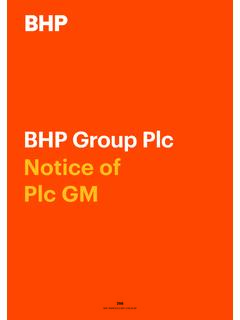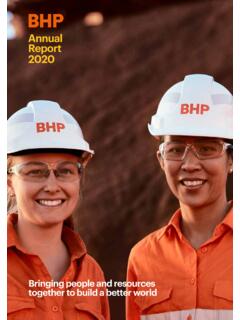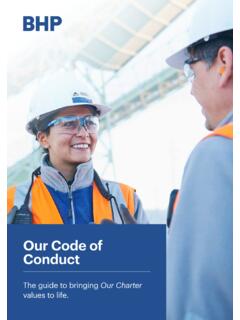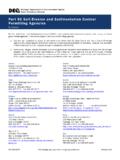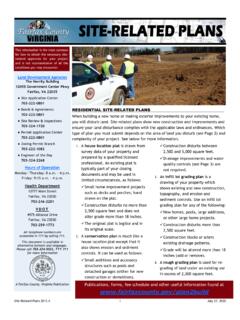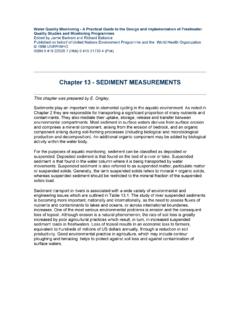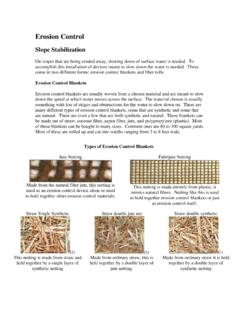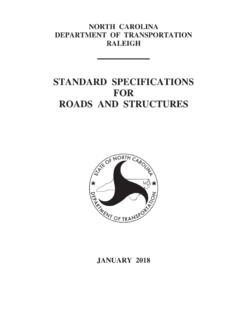Transcription of I3 — Risk Matrix and Impacts Table - BHP
1 I3 Risk Matrix and Impacts TableWater Management Failure Assessment RegisterConsequenceLevel 1 Level 2 Level 3 Level 4 Level 5 Level 1 Level 2 Level 3 Level 4 Level 5 Happens HighHighExtremeExtremeExtremeCould easily happenModerateHighHighExtremeExtremeCoul d happen and has occurred here or LowModerateHighExtremeExtremeHasn't happened yet but couldLowLowModerateHighExtremeConceivabl e, but only in extreme circumstanceLowLowModerateHighHighPrepar ed for BMA May 2009 ESTABLISH THE CONSEQUENCE OR SEVERITY & ASSIGN A RATING OF LEVEL 1 TO 5 ASSESS THE RISKSPROBABILITY FACTORCONSEQUENCE SEVERITYUSING THE Matrix BELOW DETERMINE THE RISK CATEGORY1 event per 10 to 100 years ( within a single mine life)Less than 1 event per 100 years ( within life of BMA)Frequency ExamplesESTABLISH THE PROBABILITY FACTOR OF THE EVENTD escriptionMore than 1 event per year1 event per 1 to 10 yearsCould easily happenCould happen and has occurred here or elsewhereHasn't happened yet but couldConceivable.
2 But only in extreme circumstancesEnvironmental ImpactLimited damage to minimal area of low significanceMinor effcts on biological or physical environmentModerate short term effects but not affecting eco-systemSerious medium term environmental effectsVery serious long term environmental impairment of eco-systemHappens oftenMore than 1 event per monthAspect ImpactsInherent RiskMitigation MeasuresResidual RiskComments/Information GapsConsequenceProbability FactorRisk RatingConsequenceProbability FactorRisk RatingErosion and sediment MobilisationSediment from earth moving and stockpiling can enter surface water runoff during rainfall events or blown by wind and discharge to watercourses leading to deleterious effects on water quality and aquatic habitats. Level 2 Could easily happenHighAppropriate design ( erosion and scour protection) for sections of pipeline crossing active floodplain and main channel;Stormwater management (development, implementation and maintenance of plan), to include: erosion control and energy dissipation, watercourse stabilisation matting, riprap and gabions;Stormwater controls and upstream treatment, infiltration devices and vegetation filters;Stabilisation techniques, revegetation;Construction to occur in dry season;Crossings to be at right angles to direction of flow;Stockpiling of topsoil located away from watercourses;Vehicle wash bay to be located away from watercourses;Minimise vegetation disturbance;Routine 2 Hasn't happened yet but couldLowConstruction timelinePollutionOily waste water (from miscellaneous plant and equipment wash water); Contaminated runoff from chemical storage areas.
3 Potentially contaminated drainage from fuel oil storage areas;Oil-filled transformer yard areas and general wash down water. Diesel and other petroleum-based fuels and lubricants used by excavation and construction machinery. Environmental and public health and safety 3 Could happen and has occurred here or elsewhereHighChemical and fuel storage areas to be appropriately bunded;Spill cleanup kits in accordance with Australian Standards (AS1940 and AS3780) to be located in convenient locations, work vehicles;Refuelling to occur in bunded areas;Should a spill occur, ensure it is contained and does not enter drainage lines or watercourses;Follow all other operational 3 Hasn't happened yet but couldModerateSpill/Emergency Response ProceduresWorks adjacent to/within drainage lines and watercoursesHaul road crossing and creek diversion construction at watercourse crossings and vehicle access crossings can alter flow characteristics.
4 Level 2 Could easily happenHighDiversion of watercourse either by low flow diversion or coffer dam with pumping construction activities that will affect existing drainage channels and control measures must only be carried out after suitable stormwater management infrastructure has been implemented onsite;Minimal disturbance by heavy earth moving equipment Vehicle crossings should be adequately designed for a range of flow conditions, including under road drainageLevel 2 Hasn't happened yet but couldLowConstruction Stormwater Management PlanFloodingPossibility of rainfall event causing:- mining pit inundation; and- damage to infrastructure (haul roads, mine infrastructure area, etc).Level 3 Could happen and has occurred here or elsewhereHighIf practical avoid major construction during wet season and try and work outside the flood plain. However if not possible, make sure a flood assessment has been conducted;Stormwater management eg drainage diversions and bunding.
5 Emergency response procedures and flood 3 Conceivable, but only in extreme circumstancesModerateEmergency Response ProceduresLack of water supplyInadequate dust suppression, soil compaction and wash down Level 3 Could easily happenHighDevelop, implement and maintain Water Supply Strategy and Emergency PlanLevel 3 Conceivable, but only in extreme circumstancesModerateWater supply source for construction CommissioningDisposal of waterImproper disposal of water used in hydrostatic testing - impact surrounding environment and receiving waters ( erosion )Level 2 Could happen and has occurred here or elsewhereModerateWater management/disposal 2 Conceivable, but only in extreme circumstancesLowPipeline failureDischarge of water to environmentLevel 2 Hasn't happened yet but couldLowHydrostatic testing procedureLevel 2 Conceivable, but only in extreme circumstancesLowOperationErosion and sediment MobilisationPermanent structures and minor earth disturbance can result in localised erosion and sediment mobilisation leading to deleterious effects on water quality and aquatic habitats.
6 Level 2 Could happen and has occurred here or elsewhereModerateStormwater management to include:- Localised erosion control and energy dissipation measures;- Stabilisation techniques, revegetation;- Routine inspection and maintenance of existing erosion and sediment control 2 Hasn't happened yet but couldLowIncomplete rehabilitationErosion and movement of sediment . Turbid and sediment laden runoff into 2 Could easily happenHighDevelop, implement and maintain Rehabilitation PlanLevel 2 Hasn't happened yet but couldLowPollutionDiesel and other petroleum-based fuels and lubricants used by operational vehicles and machinery entering watercourses. Level 2 Hasn't happened yet but couldLowChemical and fuel storage areas to be appropriately bunded;Spill cleanup kits in accordance with Australian Standards (AS1940 and AS3780) to be located in convenient locations, work vehicles;Refuelling to occur in bunded areas;Should a spill occur, ensure it is contained and does not enter drainage lines or watercourses;Follow all other operational 2 Conceivable, but only in extreme circumstancesLowNon-compliant dischargeDischarge of mine water exceeding environmental authority limits ( above background water quality) resulting in environmental impact on receiving waters, ecosystem and downstream 3 Could happen and has occurred here or elsewhereHighOperational water balance model - kept up to equipment with telemetry system on creeks, water management and maintenance of dams and water management infrastructure ( pumps and pipelines).
7 Separation of clean and dirty water of poor quality mine 3 Hasn't happened yet but couldModerateFloodingPossibility of rainfall event causing:- mining pit inundation; and- damage to infrastructure (haul roads, mine infrastructure area, etc).Level 3 Could happen and has occurred here or elsewhereHighMinimise catchment contributing to mining pits and regular monitoring of levees and bunds to protect mining pits;Monitoring and maintenance of erosion and sediment control features;Appropriate design of water management infrastructure;Emergency Response Procedures and flood 3 Hasn't happened yet but couldModerateEmergency Response ProceduresWater SupplyInsufficient water supply to meepreparation plant and water demand 3 Hasn't happened yet but couldModerateOperational water balance model - kept up to management strategy to include:- Efficient usage of water within preparation plant and industrial area;- Maximise reuse of water around the 3 Conceivable, but only in extreme circumstancesModeratePrepared for BMA May 2009 Water Management Failure Assessment


